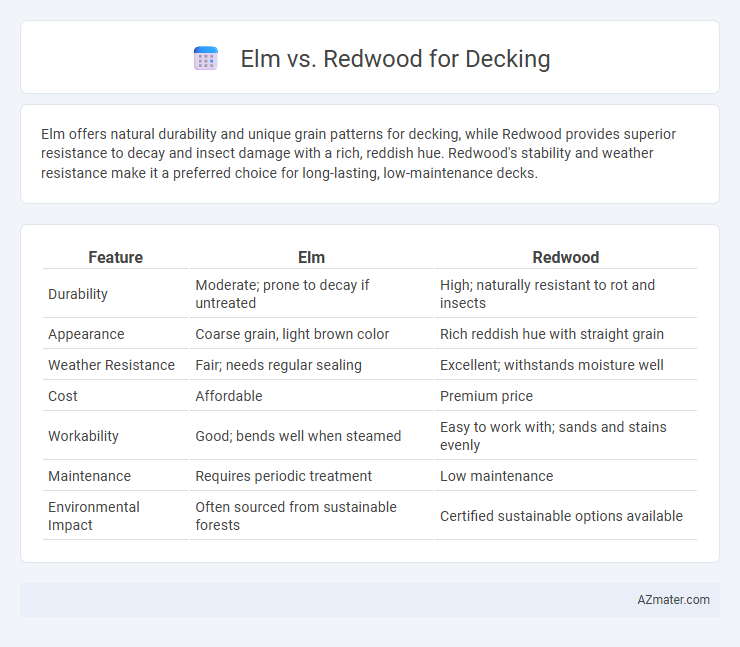Elm offers natural durability and unique grain patterns for decking, while Redwood provides superior resistance to decay and insect damage with a rich, reddish hue. Redwood's stability and weather resistance make it a preferred choice for long-lasting, low-maintenance decks.
Table of Comparison
| Feature | Elm | Redwood |
|---|---|---|
| Durability | Moderate; prone to decay if untreated | High; naturally resistant to rot and insects |
| Appearance | Coarse grain, light brown color | Rich reddish hue with straight grain |
| Weather Resistance | Fair; needs regular sealing | Excellent; withstands moisture well |
| Cost | Affordable | Premium price |
| Workability | Good; bends well when steamed | Easy to work with; sands and stains evenly |
| Maintenance | Requires periodic treatment | Low maintenance |
| Environmental Impact | Often sourced from sustainable forests | Certified sustainable options available |
Introduction to Elm and Redwood Decking
Elm decking offers a unique combination of natural durability and attractive grain patterns, making it an excellent choice for outdoor structures that emphasize aesthetics and longevity. Redwood decking is prized for its resistance to rot and insects, along with a rich color that weathers gracefully over time, providing both strength and beauty. Both wood types represent sustainable options for eco-conscious builders seeking robust, visually appealing decking materials.
Wood Characteristics: Elm vs Redwood
Elm wood offers excellent strength and shock resistance, making it highly durable for decking applications, with a Janka hardness rating around 830. Redwood, known for its natural resistance to decay and insects, features a softer texture and a Janka hardness of approximately 450, providing a smooth and stable decking surface. While Elm requires more treatment to resist moisture, Redwood's high tannin content naturally enhances weather resistance, making it a low-maintenance choice for outdoor decking.
Durability and Weather Resistance
Elm wood offers moderate durability and decent resistance to weather conditions, with natural oils that help protect it from moisture and decay, making it suitable for outdoor decking in milder climates. Redwood stands out for its superior durability, high resistance to rot, insects, and weather exposure due to its rich tannin content, which helps maintain structural integrity and aesthetic appeal over time even in harsh environments. When comparing decking materials, redwood generally provides longer-lasting performance and better weather resistance than elm, reducing maintenance needs and enhancing lifespan.
Appearance and Aesthetic Appeal
Elm decking showcases a rich, warm grain pattern with natural variations in color ranging from pale yellow to deep brown, offering a classic and rustic aesthetic ideal for traditional outdoor spaces. Redwood provides a striking reddish hue with a fine, straight grain that delivers a smooth, elegant look highly sought after for modern and upscale decking projects. Both woods age beautifully, but redwood maintains its vibrant color longer with proper maintenance, enhancing curb appeal and long-term visual impact.
Maintenance Requirements
Elm decking demands regular preventive maintenance due to its susceptibility to moisture and insect damage, requiring frequent sealing and treatment to preserve durability. Redwood offers superior natural resistance to decay and pests, significantly reducing the need for routine upkeep and extending the deck's lifespan with minimal intervention. Choosing redwood can result in lower long-term maintenance costs and enhanced aesthetic retention compared to elm.
Environmental Impact and Sustainability
Elm wood offers a favorable environmental profile due to its natural resistance to decay, reducing the need for chemical treatments and extending the lifespan of decking materials. Redwood is highly sustainable, as it is often harvested from responsibly managed forests with certifications like FSC, ensuring minimal ecological disruption and promoting biodiversity. Both woods provide eco-friendly decking options, but elm's lower processing requirements and redwood's renewable sourcing present distinct advantages in sustainable construction.
Cost Comparison
Elm decking generally costs more due to its durability and natural resistance to decay, with prices averaging between $6 to $10 per square foot. Redwood offers a more affordable option, typically ranging from $4 to $7 per square foot, while still providing strong resistance to insects and moisture. Considering both longevity and initial investment, redwood presents a cost-effective choice for budget-conscious decking projects.
Installation and Workability
Elm decking offers moderate workability with a coarse grain that requires sharp tools for smooth installation, while its resistance to splitting supports secure fastening. Redwood provides superior workability due to its straight grain and softer texture, facilitating easier cutting, shaping, and nailing during installation. Both woods are durable choices, but redwood typically allows for faster, more efficient installation due to its user-friendly characteristics.
Long-Term Performance
Elm offers moderate durability with natural resistance to decay and insect damage, making it suitable for decking but requiring regular maintenance to preserve its appearance and structural integrity. Redwood is highly valued for its exceptional long-term performance due to its natural oils that provide superior resistance to rot, warping, and insect infestation, allowing it to maintain strength and aesthetics with minimal upkeep. When considering decking longevity, Redwood typically outperforms Elm in terms of durability and low maintenance needs, making it a preferred choice for long-lasting outdoor applications.
Which Wood is Best for Your Deck?
Elm offers natural durability and resistance to decay, making it a cost-effective option for decking with a warm, rustic appearance. Redwood provides superior weather resistance, dimensional stability, and a rich red hue that enhances outdoor spaces with minimal maintenance. Choosing between elm and redwood depends on your budget, aesthetic preference, and exposure to elements for the best decking performance.

Infographic: Elm vs Redwood for Decking
 azmater.com
azmater.com